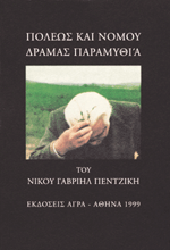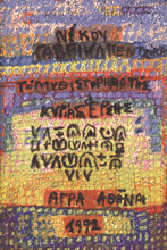 |
|
N.G. Pentzikis in 1982, holding a forget-me-not. (photo by Yannis Vanidis) |
|
Nikos Gabriel Pentzikis (1908-1993) was born, lived, and died in Thessalonica. He studied pharmacology in Paris and for many years had his own Pharmacy in Thessalonica, which also became something of a literary centre. "When I was a student in Paris, I was influenced by Norwegian and, more generally, Scandinavian Symbolist literature, and I began to move on a new level. It was then that I read the play of Luigi Pirandello Six Characters in Search of an Author. In Strasbourg, where I continued my studies, I was struck by the French writer Paul Claudel. From 1936 onwards I moved into a quite different sphere with the Byzantine chroniclers and historians. I never took particular inspiration from the classical Greek writers, apart from Pindar and Homer. I suppose I was always concerned to explore the mythical and the fairytale aspect of worldly things. The books which I published tend to set out a series of emotional frustrations. That's what made me become increasingly immersed in the style and tone of the Byzantine writers." Pentzikis was something of a black sheep in twentieth-century Greek letters. With the passing of time his reputation began to grow and his critical reception gradually developed into unqualified acclaim. His unique work as a writer is reflected also in his work as a painter, which, again, is remarkable for its distinct and highly personal style. His works include The Dead Man and the Resurrection, Icons (a collection of poems), Pragmatognosia, Architecture of a Dissolute Life, The Novel of Mrs Ersi, Mother Thessalonica, Pros Ekklesiasmon, and Archive. |


